In the United States, an average of 33 billion gallons of wastewater must be treated annually before being discharged into rivers. Just considering the electricity costs, the U.S. spends about $25 billion each year to operate its treatment systems. This does not account for the large amount of chemicals consumed, nor does it include other countries… The world is grappling with the dual challenges of clean water scarcity and increasing waste due to population pressure.
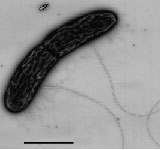 |
|
Geobacter sp |
The answer to these pressing issues lies in a technology that was first developed in 1962-1963 (by Sisler, Konikoff, Reynolds, Harris), but has been “asleep” until recent years, when the energy demand became more urgent than ever.
Microbial Fuel Cells for Waste Treatment – A Dual Benefit
“The breakdown of organic compounds in microbial cells is always accompanied by the release of electrical energy.” M.C. Porter (1911)
Since 1911, Porter asserted that electron flow always exists alongside metabolic processes in living organisms, laying the foundation for Sisler’s discovery 50 years later, where he was the first to observe current generation when microorganisms grew on a graphite anode. At that time, the current produced was too small, and the pioneers were using the growth medium as the input fuel, making this electricity expensive and difficult to apply. This is why this intriguing discovery fell into obscurity, and the mechanisms of electron release by microorganisms to the anode could not be explained, even though the metabolic pathways in cells were well understood… Only in recent years, as fossil fuel conditions began to “heat up,” has the infinite potential of microbial electricity and its practicality been recognized, prompting many scientists to focus on researching this previously “asleep” energy source.
Key Principles:
The main principle of microbial fuel cells is that the flow of electrons is transferred indirectly through the interaction between the reducing agent and the positive electrode. The spatial separation of the final electron acceptance reaction creates a difference in electromotive force, resulting in an electron flow when connecting the two electrodes with a conductor.
There are 3 main types of microbial fuel cells:
+ Type A: Intermediate electron conductors available in the environment.
+ Type B: Microorganisms with special membrane protein systems that can transfer electrons directly to the electrode.
+ Type C: Electrodes oxidized by microorganisms to generate an electron source.
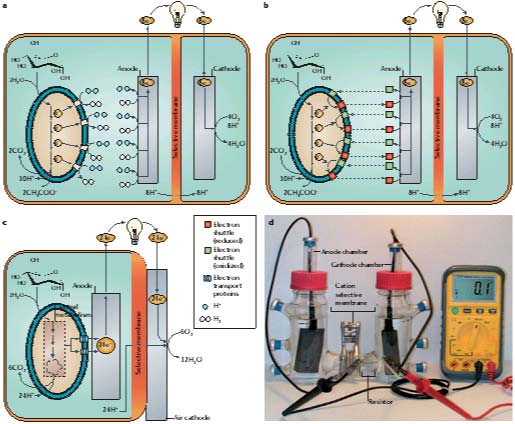
Some Notable Systems:
+ The system developed by Peter Benetto (London) utilizes an enzyme system to convert extracellular substrates in yeast: it has limited potential for large-scale application as the required substrate is Methylene blue.
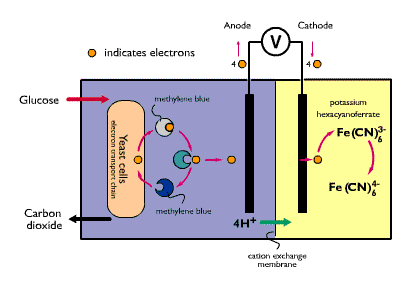
+ In 2004, the University of Pennsylvania successfully developed a system for harvesting energy from bacteria, structured like a bioreactor with a single chamber, where the fuel flow is continuously fed. With this improvement, if wastewater is used as the input, in addition to the electricity generated, the concentration of dissolved organic matter is significantly reduced. The dissolved oxygen (DO) levels in the water remain stable due to continuous oxygen diffusion for reactions at the cathode.
proton + oxygen –> water. 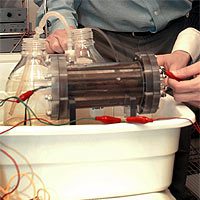
Bruce Logan, the designer of this model, states that the current challenge in applying microbial fuel cells is that the energy output is still too small, and platinum cannot be used as an electrode for large systems. However, in his view, microbial fuel cells are still a trend for the future due to their low cost, comparable to phytoremediation in wastewater treatment.
+ The system that utilizes direct electron transfer to the electrode from Geobacteraceae bacteria at NASA has a practical voltage of 0.5 volts. With an accompanying amplification system, Dr. Bruce Brittmann’s research team increased this voltage to 2 volts. NASA is currently using this system to address the waste issues of its crews.
Discoveries on Electron Transfer to the Electrode:
To explain the differences in discharge capabilities and efficiencies among various microbial species, several hypotheses have been proposed, such as the too-small contact area between electron transport proteins (ETP) and the electrodes, or many bacterial species (like E. coli, Pseudomonas, Proteus, Bacillus…) lack the ability to transfer electrons in intracellular reactions to the outside…
In the early studies of microbial fuel cells, it was hypothesized that the discharge process occurs via electron transport proteins on the membrane.
The latest discovery in microbial fuel cells is the mechanism of electron transfer from the electron donor to the final electron acceptor – a complex that transports electrons outside the cell, rather than the previously known process, where all reactions occurred within the cell, on the membrane, or in the periplasmic space.
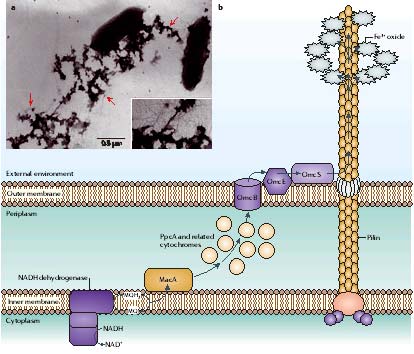
Research shows that the iron reduction process of Geobacter sulfurreducens occurs on the pili of the bacteria, with Fe(III) atoms adhering to the ends of the pili. The cell and the ends of the pili effectively resemble a pair of electrodes, which is why the electron transfer process in Geobacteraceae is found to be much more efficient compared to other bacterial types.
In addition to Geobacter, other potential bacterial species in this field include Rhodoferax ferrireducens, Shewanella putrefaciens, Aeromonas hydrophila, Desulfomonas sp… among which Geobacter sulfurreducens and Shewanella putrefaciens stand out particularly for their ability to utilize a diverse range of substrates, making them most suitable for electricity production from waste.
The results of research published in Nature Reviews 2006 represent an important discovery regarding the electron transfer mechanism, realizing the potential for improvements to apply microbial fuel cells in practice. However, another highly regarded issue here is the research environment and modeling tools for studying electrical currents in bacteria.
References:
[1] Derek R. Lovrey. Bug juice: harvesting electricity with microorganisms. Nature Rev. 4, 497-508 (July 2006)
[2] Article: NASA-supported researchers are working to develop a fuel cell that can extract electricity from human waste.
[3] Fuel-cell Microbes’ Double Duty: Treat Water, Make Energy. Science Daily (2004)
[4] Bacteria Convert Food Processing Waste To Hydrogen. Science Daily (2003)
[5] Mario Jardon. Microbial fuel cells from Rhodoferax ferrireducens (2003)
Nguyễn Hữu Hoàng


















































